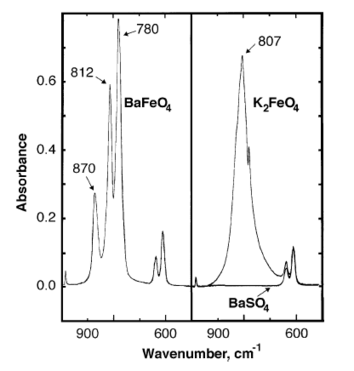Barium ferrate

| |||
| |||
| Names | |||
|---|---|---|---|
| IUPAC name
Barium ferrate(VI)
| |||
| Other names
Barium ferrate(2-)
| |||
| Identifiers | |||
3D model (JSmol)
|
|||
| ChemSpider | |||
| |||
| |||
| Properties | |||
| BaFeO4 | |||
| Molar mass | 257,1646 g/mol | ||
| Appearance | Dark red, opaque crystals | ||
| insoluble | |||
| Structure | |||
| orthorhombic | |||
| Pnma, No. 62[1] | |||
Except where otherwise noted, data are given for materials in theirstandard state(at 25 °C [77 °F], 100 kPa).
| |||
Barium ferrateis thechemical compoundof formula BaFeO4.This is a rare compound containingironin the +6oxidation state.[2]The ferrate(VI) ion has two unpaired electrons, making itparamagnetic.[3]It is isostructural withBaSO4,and contains the tetrahedral[FeO4]2−anion.[4]
Structure
[edit]Theferrate(VI)anion is paramagnetic due to its twounpaired electronsand it has atetrahedral molecular geometry.[3]
X-ray diffractionhas been used to determine the orthorhombic unit cell structure[1](lattice vectors a ≠ b ≠ c, interaxial angles α=β=γ=90°)[5]of nanocrystalline BaFeO4.It crystallized in the Pnmaspace group(point group: D2h) with lattice parametersa= 0.8880 nm,b= 0.5512 nm andc= 0.7214 nm.[1]The accuracy of the X-Ray diffraction data has been verified by the lattice fringe intervals fromHigh-Resolution Transmission Electron Microscopy(HRTEM) and cell parameters calculated fromSelected Area Diffraction(SAED).[1]

Characterization
[edit]Infraredabsorbance peaks of barium ferrate are observed at 870, 812, 780 cm−1.[7]

BaFeO4follows theCurie–Weiss lawand has amagnetic momentof (2.92 ± 0.03) × 10−23A m2(3.45 ± 0.1BM) with aWeiss constantof −89 K.[9]
Preparation and chemistry
[edit]Barium ferrate(VI) can be prepared by both wet and dry synthetic methods. Dry synthesis is usually performed using a thermal technique,[7]such as by heatingbarium hydroxideandiron(II) hydroxidein the presence ofoxygento about 800 to 900 °C.[10]
- Ba(OH)
2+Fe(OH)
2+O
2→BaFeO
4+ 2H
2O
Wet methods employ both chemical and electrochemical techniques. For example, the ferrate anion forms when a suitable ironsaltis placed inalkaline conditionsand a strongoxidising agent,such assodium hypochlorite,is added.[11]
- 2Fe(OH)
3+ 3OCl−
+ 4OH−
→ 2FeO2−
4+ 5H
2O+ 3Cl−
Barium ferrate is then precipitated from solution by adding a solution of abarium(II)salt.[11]Addition of a soluble barium salt to an alkali metal ferrate solution produces a maroon precipitate of barium ferrate, a crystal which has the same structure asbarium chromateand has approximately the same solubility.[12]Barium ferrate has also been prepared by addingbarium oxideto a mixture sodium hypochlorite andferric nitrateat room temperature (or 0 °C).[13]The purity of the product can be improved by carrying out the reaction at low temperature in the absence of carbon dioxide and by rapidly filtering and drying the precipitate, reducing the coprecipitation ofbarium hydroxideandbarium carbonateas impurities.[12]
Uses
[edit]Barium ferrate is anoxidizing agentand is used as an oxidizing reagent in organic syntheses. Its other applications include removal of color, removal of cyanide, killing bacteria and contaminated and waste water treatment.[7]
Salts of ferrate(VI) are energetic cathode materials in "super-iron" batteries. Cathodes containing ferrate(VI) compounds are referred to as "super-iron" cathodes due to their highly oxidized iron basis, multiple electron transfer, and high intrinsic energy. Among all ferrate(VI) salts, barium ferrate sustains unusually facile charge transfer, which is important for the high power domain ofalkaline batteries.[8]
Reactions
[edit]Barium ferrate is the most stable of the ferrate(VI) compounds. It can be prepared in its purest state and has the most definite composition. Barium ferrate can be easily decomposed by all soluble acids, including carbonic acid. If carbon dioxide is passed through water on which hydrated barium ferrate is suspended, barium ferrate will decompose completely to formbarium carbonate,ferric hydroxide and oxygen gas. Alkaline sulfates decompose barium ferrate that has not been dried, forming barium sulfate, ferric hydroxide and oxygen gas.
See also
[edit]References
[edit]- ^abcdNi, Xiao-Min; Ji, Ming-Rong; Yang, Zhi-Ping; Zheng, Hua-Gui (2004). "Preparation and structure characterization of nanocrystalline BaFeO4".Journal of Crystal Growth.261(1): 82–86.Bibcode:2004JCrGr.261...82N.doi:10.1016/j.jcrysgro.2003.09.024.
- ^Briggs, J. G. R. (2005).Longman A-level course in chemistry(4th ed.).Pearson EducationSouth Asia. p. 536.ISBN978-981-4105-08-8.
- ^abWiberg, Egon;Wiberg, Nils; Holleman, Arnold (2001).Inorganic chemistry.Academic Press.pp. 1457–1458.ISBN978-0-12-352651-9.
- ^Wells, A.F. (1986).Structural inorganic chemistry(5th ed.). Oxford [Oxfordshire]:Clarendon Press.ISBN978-0-19-855370-0.
- ^"IUCr".www.iucr.org.Retrieved2016-04-29.
- ^Ropp, Richard C. (2012).Encyclopedia of the Alkaline Earth Compounds.Newnes Press.ISBN9780444595539.
- ^abcHenry-Chase, Adonica; Bhushan Tewari, Brij (2013)."Use to Ferrate (VI) A Green Chemical for the Environment Remediation"(PDF).Revista Boliviana de Química.30(1): 13–23.ISSN0250-5460.
- ^abLicht, Stuart; Naschitz, Vera; Wang, Baohui (2002). "Rapid chemical synthesis of the barium ferrate super-iron Fe (VI) compound, BaFeO4".Journal of Power Sources.109(1): 67–70.Bibcode:2002JPS...109...67L.doi:10.1016/s0378-7753(02)00041-1.
- ^Audette, R. J.; Quail, J. W. (1972). "Potassium, rubidium, cesium, and barium ferrates(VI). Preparations, infrared spectra, and magnetic susceptibilities".Inorganic Chemistry.11(8): 1904–1908.doi:10.1021/ic50114a034.
- ^Sharma, R. K. (2007)."Stabilisation of Fe (VI)".Textbook of Coordination Chemistry.New Delhi:Discovery Publishing House.p. 124.ISBN9788183562232.
- ^abWulfsberg, Gary (1991)."pH and the stability of high oxidation states; Syntheses of oxo anions and their use as oxidizing agents".Principles of Descriptive Inorganic Chemistry.Sausalito, CA:University Science Books.pp. 142–143.ISBN9780935702668.
- ^abGump, J. R.; Wagner, W. F.; Schreyer, J. M. (1954). "Preparation and analysis of barium ferrate(VI)".Analytical Chemistry.26(12): 1957.doi:10.1021/ac60096a027.ISSN0003-2700.
- ^Herber, Rolfe H.; Johnson, David (1979). "Lattice dynamics and hyperfine interactions in M2FeO4(M = K+,Rb+,Cs+) and M'FeO4 (M' = Sr2+,Ba2+) ".Inorganic Chemistry.18(10): 2786–2790.doi:10.1021/ic50200a030.


